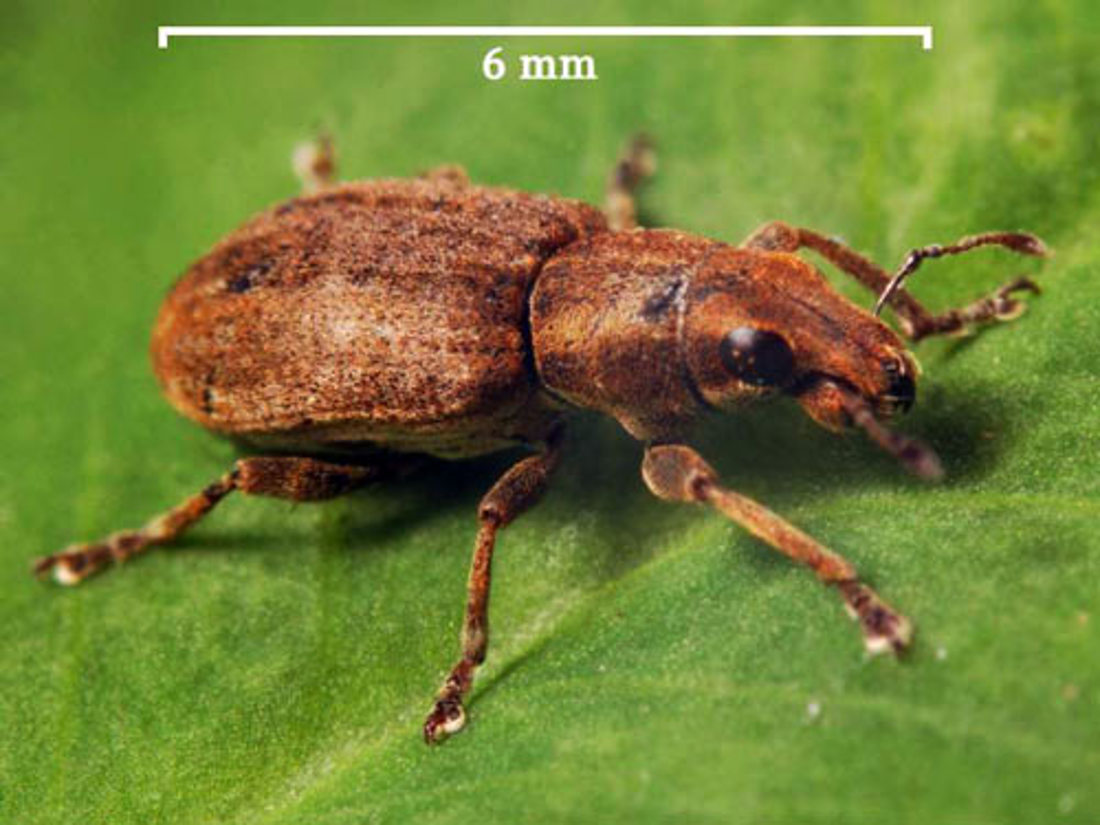Clover Root Weevil
2 min read
Clover root weevil (CRW) is a pest that affects clover, a vital plant in many pastures. The adult CRW eats clover leaves, but the more harmful larvae damage clover roots. This damage reduces the clover's ability to capture atmospheric nitrogen, impacting pasture productivity. You can identify CRW by the notching on clover leaves. Pastures with CRW might need extra nitrogen fertiliser to compensate for the damage. A parasitic wasp introduced in 2006 helps control CRW populations, although it doesn't entirely eliminate the threat.

Clover root weevil
Clover root weevil (CRW), Sitona lepidus, was first discovered in 1996 in the Waikato and Auckland and has now spread as far as Southland. In 2006, a parasitoid wasp was released in NZ to help suppress CRW populations.
White clover is its preferred host, with all cultivars susceptible, although more vigorous varieties show a level of tolerance. Both white clover and CRW go through seasonal cycles. CRW populations will tend to rise and fall with fluctuations in clover growth.
The adult weevil feeds on clover leaves. Although present all year round it is most abundant in summer. The larvae are most damaging. Although present throughout the year, they are most abundant from late autumn to early spring.
CRW can completely remove clover from pastures, decreasing pasture quality and negatively affecting nitrogen fixation. If CRW populations are high and pasture stressed, this can result in total clover loss in pastures.
Clover is a high quality food for livestock. CRW larvae and adults reduce the clover's growth rate and survival through the physical damage they cause to the roots and leaves. Thus, the amount of high quality food available to livestock is reduced.
The most obvious sign of CRW is the distinctive notching on clover leaves caused by adult feeding. If notching is observed, further evidence of CRW can be found by digging up some clover plants to look for larvae in the top 5cm of soil near clover roots.
The CRW adult is a small speckled brown weevil up to 6mm long found in the base of pasture throughout the year, but is most abundant in summer. The adult stage of CRW feeds on clover leaves and the larval stages feed on clover roots.
Young larvae tend to feed in clover root nodules (which capture atmospheric nitrogen), while bigger larvae will feed anywhere on the root system. Older larvae damage clover stolons.
CRW larvae are creamy white grubs from 1 to 6 mm long, found by digging into the root zone under white clover plants. They are present throughout the year, but most abundant from late autumn to early spring. The larval stage is the most damaging. CRW larvae feed exclusively on clover roots, and associated nodules, reducing nitrogen fixation, clover production and persistence.
Clover roots capture nitrogen from the atmosphere. Livestock eat the clover (along with the nitrogen it has captured), then return the nitrogen to the pasture in their urine and dung. This nitrogen then becomes available to increase the growth of other pasture plants such as ryegrass. Clover therefore provides 'free' nitrogen fertiliser.
When CRW feeds on clover roots, they reduce the amount of nitrogen that can be provided by clover, and this must be supplemented with nitrogen fertiliser to maintain productivity.
In the North Island, CRW damage is particularly significant in dairy pastures. North Island dairy farmers have reported substantial loss of productivity due to CRW, with reductions in nitrogen fixation by clover of 50% to 100%. The amount of nitrogen fertiliser needed to compensate for CRW varies with soil type, fertility and climate.
In 2006 AgResearch introduced a small parasitic wasp (Microctonus aethiopoides) as a biological control agent against clover root weevil. It lays an egg inside the adult CRW, which immediately stops the weevil from being reproductive.
After a major release programme by AgResearch with support from DairyNZ, this biological control agent is now present in most areas of the North and South Islands. The wasp is also spreading naturally from release points at the rate of 15-20 km per year.
Once established the wasp may take 2-4 years to effectively control CRW populations and for clover to return to pastures. It will not eliminate damage altogether and there will be cycles when CRW populations increase again before the parasitoid can bring it under control.
Now’s the perfect time to check in, plan, and set up for a strong season. We’ve pulled together smart tips and tools to help you stay ahead all winter long.
Whether you prefer to read, listen, or download handy guides, we’ve got you covered with trusted tools to support your journey every step of the way.
Put our proven strategies and seasonal tools to work. Boost production, support animal health and watch your profits hum.
Tools that are backed by science, shaped by farmers and made for this season.
That’s Summer Smarts.